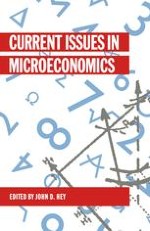1989 | OriginalPaper | Chapter
General Equilibrium and Disequilibrium and the Microeconomic Foundations of Macroeconomics
Author : Paul Madden
Published in: Current Issues in Microeconomics
Publisher: Palgrave Macmillan UK
Included in: Professional Book Archive
Activate our intelligent search to find suitable subject content or patents.
Select sections of text to find matching patents with Artificial Intelligence. powered by
Select sections of text to find additional relevant content using AI-assisted search. powered by
The elementary theory of consumer and producer behaviour under competitive conditions, and the resulting elementary supply/demand model of the partial equilibrium of a single market are the foundations on which the models of general (economy-wide) Walrasian equilibrium are built. By 1960 a rigorous development of such models, in the context of what has become known as the Arrow-Debreu economy, had taken place. As economy-wide models, these can claim to be macroeconomic; and yet their clear specification of the behaviour of individual agents (consumers and firms) which leads to the macroeconomic outcome, gives them a microfoundation. However, at that time they presented a dilemma to economic theory, since most of the central features of interest to macroeconomists (including e.g. money, expectations, involuntary unemployment) are missing from these Walrasian, Arrow-Debreu models. On the other hand, the then popular macroeconomics built on aggregate demand/supply analysis, IS-LM analysis and the Phillips curve trade-off between output and inflation clearly involved money, expectations, etc., and thus did not rest on the Walrasian, Arrow-Debreu base; the appropriate microeconomic foundation for this macroeconomics was not clear. From then on it is possible to identify a number of themes in the literature aimed at providing a microfoundation for macroeconomics. The objective of this chapter is to introduce the reader to some of the important surviving themes from this literature.
